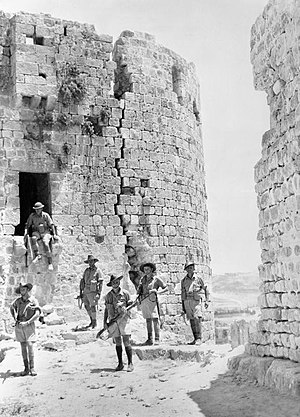Operation Exporter
| Syria–Lebanon campaign | |||||||||
|---|---|---|---|---|---|---|---|---|---|
| Part of the Mediterranean and Middle East theatre of the Second World War | |||||||||
 Australian troops among the ruins of the old Crusader castle at Sidon, Lebanon, July 1941 |
|||||||||
|
|||||||||
| Belligerents | |||||||||
|
|
|
||||||||
| Commanders and leaders | |||||||||
|
|
|
||||||||
| Strength | |||||||||
| ~34,000 troops 50+ aircraft 1 landing ship 5 cruisers 8 destroyers |
45,000 troops 90 tanks 289 aircraft 2 destroyers 3 submarines |
||||||||
| Casualties and losses | |||||||||
|
c. 4,652 Australian: 1,552 Free French: c. 1,300 British and Indian: 1,800, 1,200 POW, 3,150 sick 27 aircraft |
6,352 (Vichy figures) 8,912 (British figures) 179 aircraft 1 submarine sunk 5,668 defectors |
||||||||
The Syria–Lebanon campaign, also known as Operation Exporter, was the British invasion of Vichy French Syria and Lebanon from June–July 1941, during the Second World War. The French had ceded autonomy to Syria in September 1936, with the right to maintain armed forces and two airfields in the territory.
...
Wikipedia
